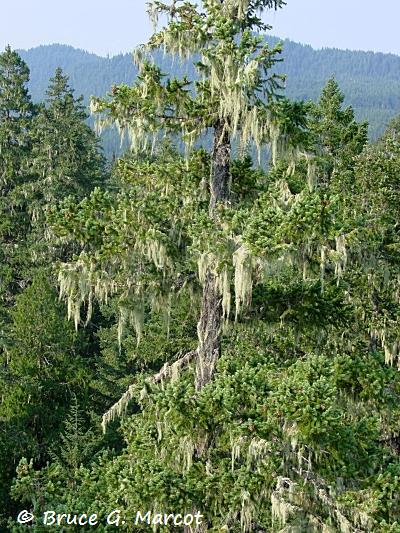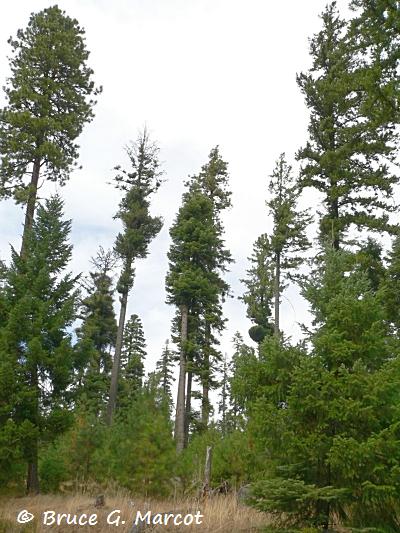|
Explanation: What's
wrong with these trees? They seem to have grown spindly and narrow, with
odd dense clumps of thick branches. This
growth form is called epicormic branching and it seems to be a
characteristic of these old-growth Douglas-fir trees. So,
what significance is this to the biodiversity of old-growth conifer forests? Well,
it is known that such tree growth structures -- with narrowing of the foliage
canopy -- can create very deep canopies in well-established, old-growth
forests where, otherwise, lower branches would have died back from
self-pruning as they would have gotten shaded out. This
serves to retain much foliage volume that is habitat to a variety of bird and
mammal species such as warblers, creepers, martens, fishers, and others ... as
well as habitat substrates for lichens and mosses that drape along the
branches, as shown below.

Pendant lichens -- old man's beard -- on an old-growth Douglas-fir
in the Cascade Mountains of southern Washington state, USA.
Some evidence suggests that perhaps the tight, tall form of Douglas-fir trees
with epicormic branches helps the trees to withstand disturbances and to
maintain their physical dominance. This contributes to the trees'
genetic fitness and allows old-growth Douglas-fir forests to persist for
centuries. Such longevity can have important implications also for
persistence of old-growth associated wildlife such as the Northern Spotted Owl
(Strix occidentalis caurina) that finds optimal habitat in such
forests.
So, as
odd as these trees look, there is an adaptive function and much secondary
benefit to the biodiversity of the forest.

Information:
Bond, B. J., and J. F. Franklin. 2002. Aging in Pacific Northwest forests: a selection of recent research. Tree Physiology 22:73-76.
Bryan, J. A., and R. M. Lanner. 1981. Epicormic branching in Rocky Mountain Douglas-fir. Canadian Journal of Forest Research 11:190-199.
Ishii, H., and E. D. Ford. 2002. Persistence of
Pseudotsuga menziesii (Douglas-fir) in temperate coniferous forests of the Pacific Northwest Coast, USA. Folia Geobotanica 37(1):63-69.
Ishii, H., and M. E. Wilson. 2001. Crown structure of old-growth Douglas-fir in the western Cascade Range, Washington. Canadian Journal of Forest Research 31:1250-1261.
Lanner, R. M. 2002. Why do trees live so long? Ageing Research Reviews 1(4):653-671.
|
Index |
Location | Search | About EPOW | ... Next >